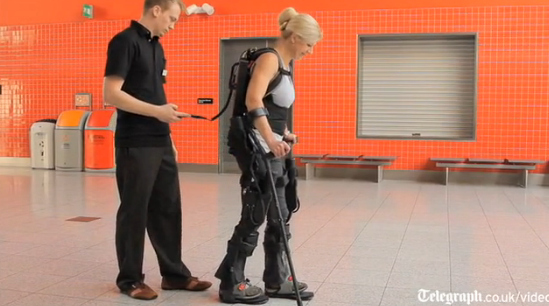 A woman who was paralysed from the waist down in a skiing accident has walked again with the aid of a robotic suit.
A woman who was paralysed from the waist down in a skiing accident has walked again with the aid of a robotic suit.
The Ekso device was demonstrated for the first time in Europe on Friday at the London International Technology Show. The bionic legs detect small movements in the upper body of the wearer and then translates these into strides.
Paralysed in 1992, Amanda Boxtel was given the chance to try out Ekso at the technology show. She told the Telegraph that after walking with the aid of the robotic suit, she returned to her hotel room and cried. She described them as “life changing.”
“To walk with my knees bent, heels striking the ground again is just amazing,” she said. “If I had this at home, I’d use it every day. To enjoy the simple pleasures of being able to reach up to a top cupboard in my kitchen would be fabulous. At a cocktail party, rather than looking up at nostrils and chins, I’d be able to stand eye to eye.”
She added, “Our bodies are meant to be up and moving, not sitting around in a wheelchair, stagnant.”

Eythor Bender, chief executive officer of Berkeley-based Ekso Bionics in California, said the robotic suit was born out of an idea to give soldiers on the battlefield superhuman strength. After coming up with a design, researchers then decided to adapt it to make it useful for people with spinal problems.
“We want to enhance their independence and freedom of movement and with Ekso they now have the option to stand and walk for the first time since their injury,” said Bender.
Bender explained how sensors in the suit detect a person’s movements. A computer translates these and drives special motors located under the knees and hips to move the person forward.
The Ekso robotic suit, while expensive at around $160,000 (£100,000), would be a great tool for places such as rehabilitation centers. And if the cost can be brought down, it might one day enable paraplegics everywhere to enjoy a more independent and mobile life.


